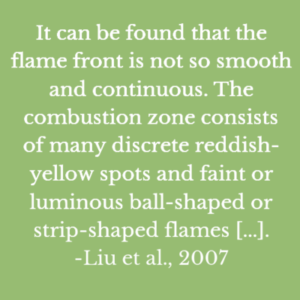1-Sentence-Summary: Hybrid mixture flame structure, flame temperature, and particle velocity is analyzed in a vertical flame tube open at one end.
Authors: Y. Liu, J. Sun, and D. Chen
Read in: Three Minutes
Favourite quote from the paper:

These authors present explosion results for hybrid mixtures in a vertical flame tube. The tube is 500 mm high and 80 mm by 80 mm wide. The mixtures are ignited using tungsten wire electrodes and a 100 ms delay is used after injection.
The methane gas concentration is held constant at 2.2% by volume and the coal dust concentration is varied between 37.5 and 125 g/m3. The particles have a mean diameter of 54 µm and contain approximately 83% volatiles by weight.
High speed photographs are presented for the hybrid flames. Flame propagation velocity and particle velocity are also analyzed. Lastly, flame temperature is measured at fixed points in the tube.
Three of the main findings from this paper are:
- Particle velocity is in the same direction as the propagating flame and the particles decelerate as the flame passes.
- Hybrid flame structure is thicker than gas flames, and individual particle combustion is shown at low dust concentrations.
- Flame temperature has two local peaks: one when the flame front passes and one behind due to later time combustion.
The following sections outline the main findings in more detail. The interested reader is encouraged to view the complete article at the link provided below.
Finding #1: Particles travel in the same direction as the flame and decelerate during flame passage
For the lowest dust concentration tested (37.5 g/m3) individual particles can be distinguished in the high speed photographs. This allows particle velocity tracking in relation to the flame front.
The flame propagation speed has a constant value of 7.5 m/s between 40 and 50 ms. Two of the particles shown in high speed images are traveling in the same direction of the flame and have velocities of 5 to 6 m/s prior to the flame passage. Both particles decelerate to approximately 4 m/s during the flame passage. The flame front and particle velocities are both impacted by combustion reaction and expansion of the combustion products.
Finding #2: Hybrid flames are an order thicker than gas flames and particle reaction times are milliseconds
The flame front is not smooth and continuous for the 37.5 g/m3 particle concentration. Instead it consists of discrete spherical or strip-shaped flames, around individual particles.
Increasing the particle concentration causes the flame to appear more continuous. The flame thickness is between 10 and 20 mm for a particle concentration of 56.3 g/m3. Burning times for individual particles are between 3 and 7 ms.
Finding #3: Two peaks are shown when the flame passes a fixed point in the explosion chamber
Thermocouples are used to measure temperature during passage of the flame. For 56.3 g/m3 of coal dust, two individual peaks in temperature are shown. One during the passage of the flame and a second peak 400 ms later. The authors suggest that the first peak is due to smaller particles burning and that the second peak is due to larger particles. It seems likely that later time carbon burning (e.g., see Bai et al., 2011) may also play a role.
My Personal Take-Aways From
“Flame Propagation in Hybrid Mixture of Coal Dust and Methane”
This paper is unique due to the high-speed photograph and Schlieren image quality. It is one of the first papers in the hybrid explosion literature that show the transition between discrete and continuous flame structures. This also allows the flame thickness, particle combustion times, and particle velocity to be analyzed.
This paper is recommended for anyone studying hybrid mixture explosion or hazards in the mining industry. Furthermore, the results are useful for explaining hybrid flame propagation processes and as validation cases for numerical simulation. A difficulty here is that the turbulence level in the vessel is unknown. Two papers are also referenced in this work that are not typically given elsewhere and may be useful for understanding coal dust explosion: Horton et al., 1977 and Slezak et al., 1983.
Full Citation: [bibtex file=references.bib key=Liu2007]
[otw_shortcode_button href=”https://www.sciencedirect.com/science/article/pii/S0950423007000629″ size=”medium” icon_position=”left” shape=”square”]> > Get The Article[/otw_shortcode_button]
